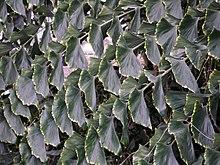| Caryota no | |
|---|---|
 | |
| Scientific classification | |
| Kingdom: | Plantae |
| Clade: | Tracheophytes |
| Clade: | Angiosperms |
| Clade: | Monocots |
| Clade: | Commelinids |
| Order: | Arecales |
| Family: | Arecaceae |
| Genus: | Caryota |
| Species: | C. no |
| Binomial name | |
| Caryota no | |
| Synonyms[3] | |
Caryota no is a species of flowering plant in the family Arecaceae. It is endemic to the Island of Borneo.[3][1][4] Its specific epithet is from the common name in Malaysian, cajù nó.[2] It is called baroch by the Dayak people of Singhi.[2] The fibers, which are used for fishing lines or woven into baskets, are called talì onus.[2] The extremely hard wood is also used like similar species.[2]
References
- ^ a b Johnson, D. 1998. Caryota no. 2006 IUCN Red List of Threatened Species. Archived June 27, 2014, at the Wayback Machine Downloaded on 20 July 2007.
- ^ a b c d e f Beccari, Odoardo (1871). "Note Sopra Alcune Palme Bornensi" (PDF). Nuovo Giornale Botanico Italiano (in Italian). 3: 12–15. Retrieved 16 March 2018.
- ^ a b "World Checklist of Selected Plant Families: Royal Botanic Gardens, Kew". apps.kew.org. Retrieved 16 March 2018.
- ^ Govaerts, R. & Dransfield, J. (2005). World Checklist of Palms: 1-223. The Board of Trustees of the Royal Botanic Gardens, Kew.
